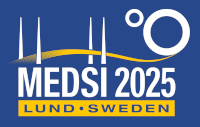Speaker
Description
Mu2e, the Muon-to-Electron Conversion Experiment, aims to identify physics beyond the Standard Model, namely, the conversion of muons to electrons without the emission of neutrinos$*$. The muons are produced from pions generated in a production target when it is hit by an 8 GeV proton beam from the Fermilab Booster. The target design is constrained by the one-year operating lifetime and radiative cooling in a vacuum environment. Uncertainties in the lifetime of the existing baseline design – a monolithic, segmented tungsten target – are large, particularly due to unknown impacts of radiation damage at the high proton fluences expected in experiment. A new design utilizing Inconel 718 over the WL10 used in the existing target design has been evaluated. The resultant structural design of the target has evolved significantly. The focus is on lowering the target temperature, minimizing obstruction to muons, increasing structural stability, maximizing fatigue lifetime, simplifying the fabrication process, and more. The thermal management, structural stability and fatigue lifetime are emphasized here. The optimizations have led to a promising new target design for the Mu2e experiment.
Footnotes
$*$ L. Bartoszek, et al. Mu2e Techincal Design Report, 2015, arXiv:1501.05241v2

